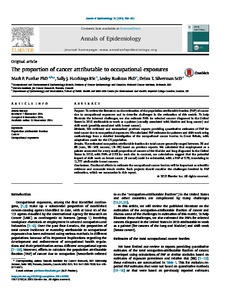The proportion of cancer attributable to occupational exposures

Purdue, Mark P. ; Hutchings, Sally J. ; Rushton, Lesley ; Silverman, Debra T.
2015
25
3
188-192
aetiology ; cancer ; epidemiologic study ; occupational disease ; occupational risks
Occupational diseases
http://dx.doi.org/10.1016/j.annepidem.2014.11.009
English
Bibliogr.
"PURPOSE:
To review the literature on the estimation of the population attributable fraction (PAF) of cancer due to occupational exposures and to describe challenges in the estimation of this metric. To help illustrate the inherent challenges, we also estimate PAFs for selected cancers diagnosed in the United States in 2010 attributable to work as a painter (causally associated with bladder and lung cancer) and shift work (possibly associated with breast cancer).
METHODS:
We reviewed and summarized previous reports providing quantitative estimates of PAF for total cancer due to occupational exposures. We calculated PAF estimates for painters and shift work using methodology from a detailed investigation of the occupational cancer burden in Great Britain, with adaptations made for the US population.
RESULTS:
The estimated occupation-attributable fraction for total cancer generally ranged between 2% and 8% (men, 3%-14%; women, 1%-2%) based on previous reports. We calculated that employment as a painter accounted for a very small proportion of cancers of the bladder and lung diagnosed in the United States in 2010, with PAFs of 0.5% for each site. In contrast, our calculations suggest that the potential impact of shift work on breast cancer (if causal) could be substantial, with a PAF of 5.7%, translating to 11,777 attributable breast cancers.
CONCLUSIONS:
Continued efforts to estimate the occupational cancer burden will be important as scientific evidence and economic trends evolve. Such projects should consider the challenges involved in PAF estimation, which we summarize in this report."
Digital
The ETUI is co-funded by the European Union. Views and opinions expressed are however those of the author(s) only and do not necessarily reflect those of the European Union or the ETUI.